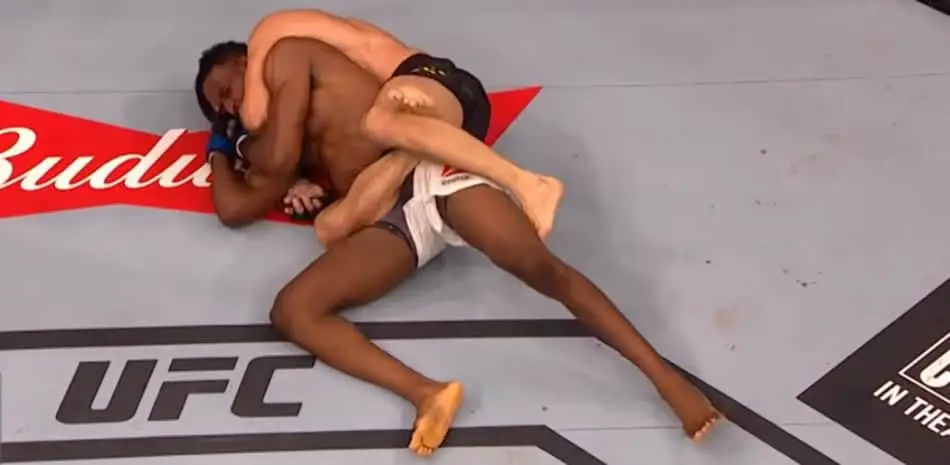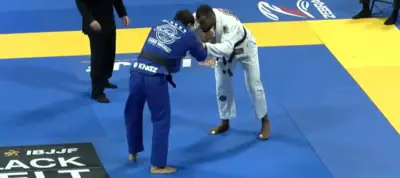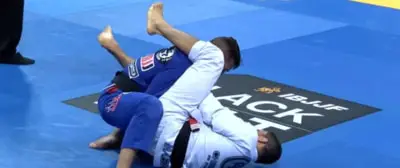
Many people consider BJJ as the best martial art out there. When it comes to determining how effective martial art is I personally always look at 3 things:
- How realistic the martial art is? – Can you use in a self-defense situation or it’s too sport-focused?
- How long does it take before a beginner can use it effectively on untrained people?
- Is it used effectively in the highest levels of Mixed Martial Arts competition?
When trying to answer those questions for BJJ, they are actually quite positive. So to answer your question:
Is BJJ an overrated martial art? No, BJJ isn’t overrated. It’s actually the most effective martial art for 1 vs 1 combat because some of the techniques and principles it teaches are pretty simple yet very effective. Even someone with a little BJJ training can beat with ease untrained person the same size as him/her or a little bigger.
At first, the goal of BJJ was to be the ultimate martial art that was designed to help the little guy/girl defend themselves from someone bigger and stronger by using proper technique, leverage, and position principles.
It was still grappling heavy sport but there was also striking. As the sport evolved it become a pure grappling martial art in which most of the exchanges happened on the ground.
Did that make it a less effective martial art? The answer is yes and no. Yes because in a self-defense situation there will be strikes 100% so you have to be prepared for that. And no because as the focus shifted towards ground game, BJJ became the ultimate ground fighting sport out there.
In the rest of the article, I’m going to answer in detail the 3 questions that determine how effective martial art is, which I mentioned at the beginning.
How Effective is BJJ for Self-Defense
The coolest thing about BJJ is that most other sports don’t have is the unpredictability. When fighting a boxer or a kickboxer you pretty much know how he is going to attack you. And even if to knock someone out who doesn’t defend himself properly is easy, the task becomes 10 times harder when he is simply keeping his hands up.
When rolling with a BJJ practitioner and you never practiced BJJ you have no idea what’s going on. You don’t know how to resist the attacks and often BJJ fighters can use your resistance against you to get you in another submission. BJJ has by far the biggest variety and most dangerous submission of all grappling martial arts (judo, sambo, catch wrestling).
There are chokeholds, arm and leg locks, and neck cranks and submissions attacking the spine. While chokeholds are definitely the deadliest, every BJJ submission can finish the fight by causing unbearable pain if you put enough force into it.
Positioning
The other focus of BJJ is positioning. One of the golden rules is “position before submission”. Which means to always try to get a dominant position on the ground before attacking for submission. Dominant positions in BJJ are:
- Side-control – When you are on top of your opponent chest to chest but your bodies are at about 90 degrees angle
- Knee on belly
- Mount – When you are on top of your opponent and you passed his legs
- Back Control – When you are on your opponent’s back (just like a backpack)
- Back Mount – The most dominant position – you have back control but you are also on top of your opponent.
- Headlock positions – That can be front headlock, bulldog choke position or guillotine position.
There are also other dominant positions when attacking the opponent’s limbs. For example armbar position; ashi garami – position for attacking for leg locks.
A lot of those positions are great not only for submissions but also for landing strikes. Especially the positions mount, back control, back mount and front headlock position.
In BJJ competitions strikes aren’t allowed. But in MMA or in a self-defense situation you can use your positioning skills from BJJ to get into a top/dominant position from where you can throw punches, elbows, and knees. And that combined with the submission threat makes BJJ much more dangerous.
For example, if in a street fight you mount someone who has no grappling skills the fight is pretty much over. He won’t be able to escape (besides if he is much bigger than you. Then there’s a chance he can just bench-press you).
Positioning is great for offense but it can be used also defensively. The first thing you will learn in a BJJ class is called “BJJ closed guard”. That’s when you are on your back and your opponent is on top of you but you have wrapped your legs around his body and locked them together.
That’s probably the best defensive position in which you can be on the ground. The legs are very strong and you can control the whole body of the opponent just with your legs. Even though you are on your back if you get your opponent in a closed guard and you have decent BJJ skills, he won’t be able to punch you effectively and you can directly attack for submissions (triangle chokes, armbars, guillotines, kimuras).
Pros of BJJ for self-defense:
- Fast effectiveness – Training for 6 months can give you enough skill to beat pretty much everyone with no grappling skills who is the same size as you or a little bigger. Train for 2 years and you’ll be able to submit significantly bigger unrained people.
- Negates the puncher’s chance – When being in a stand-up boxing/kickboxing fight there’s always a chance to get caught and knocked out even if you are the better striker. There’s no such chance when fighting on the ground.
- Can be used in every situation – Kickboxing can be very effective on a street or alley but what about if you have to defend yourself in an elevator? BJJ can be effective in open spaces such as streets but also in tight spaces such as elevators, cars, etc.
- Effective against bigger people – No matter how bigger than you someone is, he doesn’t have a high chance of beating you when you are on his back choking him.
Cons of BJJ for self-defense:
- No striking
- Not enough focus on takedowns
BJJ practitioners focus too much on the ground game and the submissions and often neglect to work on their takedowns and takedown defense. Most pure BJJ fighters don’t have great takedowns.
And that’s a big problem because BJJ is effective only on the ground. Besides guillotine, there are no other submissions you can apply while standing. That’s why I recommend doing wrestling and/or judo as well as BJJ.
Is BJJ used Effectively in MMA?
BJJ became popular worldwide after Royce Gracie won UFC 1 in 1994 using his BJJ skills. He submitted wrestlers, boxers/kickboxers are people with a background in traditional martial arts. Because of that, many people started believing that BJJ is the best martial art.
But in today’s MMA, pure BJJ skills aren’t enough to be successful. That’s because of 3 reasons:
1. Modern MMA fighters know the tricks – Back in 1994 no one of Royce Gracie’s opponents knew what armbar or triangle choke is. They believed they are in a dominant position in his guard. They didn’t know how to defend those submissions simply because no one ever submitted them like that during practice.
Nowadays every MMA fighter, no matter what his background is, practices BJJ. They know a big part of the set-ups BJJ guys use to get you in a submission. So BJJ fighters have to be much more crafty if they want to secure the sub.
If you roll with someone with better BJJ skills chances are that he’ll eventually submit you but that’s very hard especially if you are willing to play defensively and stall.
2. Most BJJ practitioners don’t have great takedowns – The focus of BJJ is on getting a dominant position and submitting the opponent. So, as I already mentioned, pure BJJ fighters don’t spend enough time working on their takedown skills which is a crucial part of the MMA game. While it’s easy to take untrained people down just with a decent technique, to take an MMA fighter you need to have great technique and/or timing and strength.
Most MMA fighters today (at least on the higher levels) have a very good takedown defense especially if they have a wrestling background.
The inability to take somebody to the ground makes all your BJJ skills useless. That’s why we often see great BJJ guys beaten by strikers or wrestlers who use striking. They simply avoid the ground game with the better BJJ fighter and outstrike him on the feet.
3. Modern MMA Rules aren’t suited to BJJ – Nowadays standard MMA fights are 3 rounds 5 minutes each and title fights – 5 rounds (5 minutes each). But those rules aren’t exactly in favor of BJJ.
BJJ bouts don’t have rounds. Most matches are 10 minutes long but there are also 20-minute matches and even matches with no-time limit – the competitors roll until someone gets the submission. For example, the no time-limit match Keenan Cornelius vs Gordon Ryan is 1.5 hours long!
The initial idea of BJJ is that it is a fight to the death. As it first became a popular sport in Brazil, some matches lasted more than 2 hours.
In modern MMA BJJ practitioners don’t have much time to work. There are 5 minutes round and every round starts on the feet. Let’s say you are a BJJ fighter and you can close the distance and secure a takedown for 2 minutes. That means you have only 3 minutes left to get into a better position and submit the opponent. That’s nowhere near the time you have in a 10 or 20 minute BJJ match not to mention the no-time limit matches.
If in MMA a striker or a wrestler ends up on the ground with a BJJ fighter all they need to do is to stall the fight and survive for a few minutes before bell saves them.
Some BJJ practitioners say that this is unfair and MMA matches should have either one 15-minute or 25 minute round with no break or at least the fighters should start the next round in the same position they were at the end of the last round.
If some organization adopts such rules I guarantee we’re going to see many more submissions. I’m not saying that BJJ is perfect but today’s rules can definitely trick you and make you think that BJJ isn’t as effective as it actually is.
Gi BJJ
Originally BJJ was practiced with a Gi – kimono-like jacket, pants, and a belt. But since MMA fighters fight shirtless, people started practicing No-Gi BJJ. Instead of a Gi, they wear rashguards and shorts instead of their Gi pants.
The difference between the two types of BJJ are manly the grips. In Gi, there are many more places where you can grab the opponent (sleeves, collars, lapels, and others) and there are more chokeholds in Gi because of the collars (clock choke, loop choke, brabo choke and others).
There are debates about which type of BJJ – Gi or No-Gi is more effective on the street. That really depends on how the person you fight with is dressed. If he has a jacket and long pants that almost the same as Gi BJJ (Gi jacket may be much more durable than a standard jacket though). And if the person is wearing a T-shirt and shorts that’s the same as No-Gi.
Honestly, it doesn’t matter that much what’s your specialty (Gi or No-Gi) when fighting an untrained opponent as long as you are decent at BJJ. You’ll probably submit him no matter if he is wearing a jacket and you train mostly No-Gi or vice versa.
I would recommend trying both Gi and No-Gi and deciding which one you like better. If you like Gi more train more in Gi. For instance, if you go to the BJJ gym 3 times a week, train 2 times in a Gi and 1 time No-Gi.
I personally prefer No-Gi mostly because my grips aren’t that strong which is important in Gi BJJ and not a big deal in No-Gi.
How to Make Sure your BJJ will be Effective for Self-Defense
As I mentioned, BJJ has some flaws when it comes to self-defense. So here are my top tips to make your BJJ more effective in a “street fight”:
1. Try to always be on top while rolling – Pulling guard and letting come to your closed guard so you can attack for triangles and armbars can be cool in the gym but it’s a no-go in a street fight. Being on top = winning; being on bottom = losing. When you are in a top position, you have better control, you can land strikes or disengage easier. Also if you are fighting on concrete you definitely don” want to end up on your back.
2. Practice wrestling or Judo once a week – Learn to take people down. A Judo or wrestling class a wee will help you do that. Also, try to start rolling from a standing position more often (not always but more often)
3. Practice BJJ with striking from time to time – That’s what people in some MMA gyms do every 2-3 weeks they put on small gloves and practice rolling with throwing light punches. That will make you more aware of which positions are dangerous for you in a street fight where the other person can throw strikes and which positions are good for you to land some ground-and-pound.



